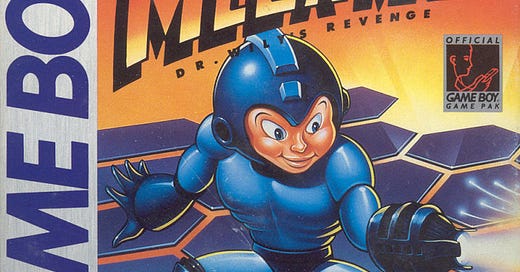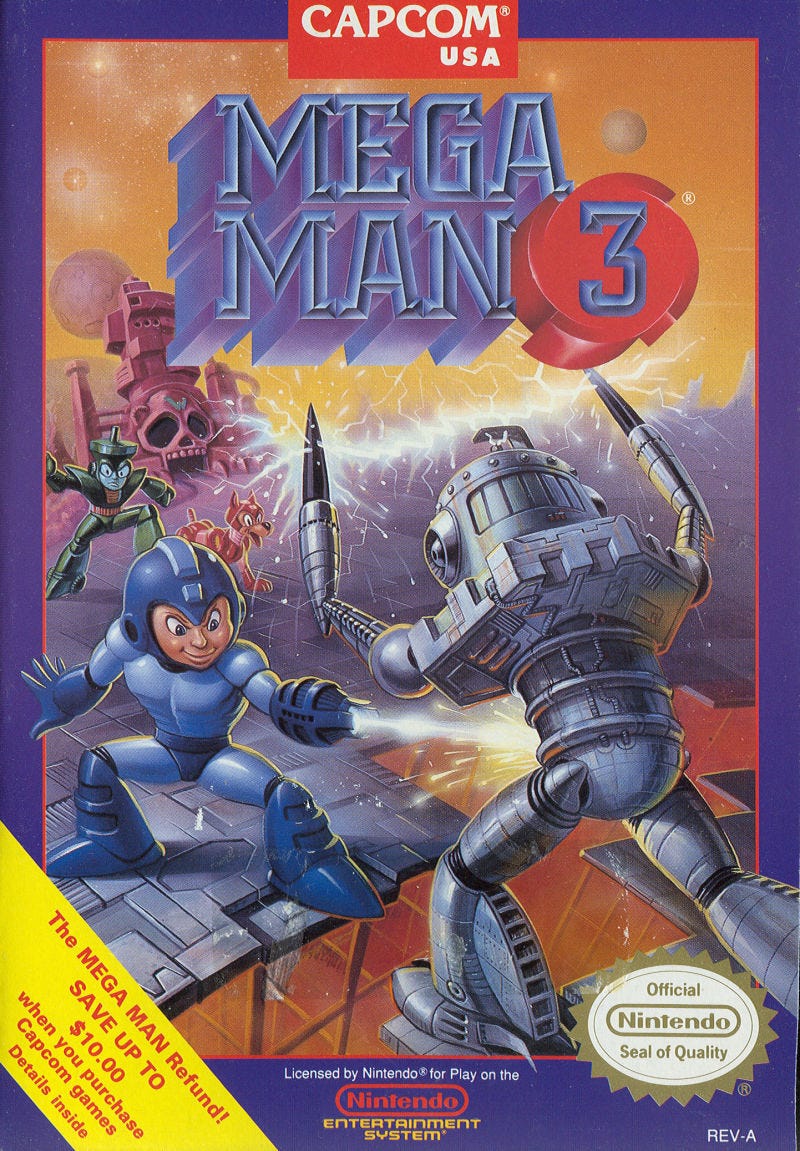It's new to me: Mega Man: Dr. Wily's Revenge
The blue android's Game Boy debut is fine, but probably felt better in 1991
This column is “It’s new to me,” in which I’ll play a game I’ve never played before — of which there are still many despite my habits — and then write up my thoughts on the title, hopefully while doing existing fans justice. Previous entries in this series can be found through this link.
We’re in an age now where a new Mega Man title is something of a rarity, regardless of which series you’re even referencing. Mega Man 11 came out in 2018, and is the third of the throwback-y sequels to the series that’s come out since 2008’s NES-styled Mega Man 9. There hasn’t been a new Mega Man X title for consoles since 2004, and the various spin-off series — Xtreme, Zero, Battle Network, Star Forces — all released for handhelds whose days are long past.
Back in Mega Man’s heyday, though, there was a new Mega Man game what felt like every few months. Sometimes, that’s because a few months was all that separated the releases. In 1987, the first Mega Man released for the Famicom/NES in Japan and North America, with Mega Man 2 coming the next year. Mega Man 3 released in 1990, and then, the floodgates opened: 1991 would feature Mega Man’s Game Boy debut, Mega Man 4 on the NES, and Mega Man II, a Game Boy sequel in the spin-off series — yes, the first Game Boy Mega Man and its sequel arrived in the same year in Japan. Mega Man 5 and Mega Man III would come out in 1992, IV for the Game Boy and 6 for the NES in 1993, as well as the first Mega Man X game for the SNES. In ‘94, the Sega Genesis finally got in on the Mega Man action with Wily Wars, a compilation of remakes of the first three NES games, and at the same time, Mega Man X2 released on the SNES, Mega Man Soccer for the SNES marked the original’s debut on that system, while Mega Man V released as the final Game Boy title in that series. The Game Gear would see its own Mega Man debut in 1995, at the same time Mega Man first appeared on the SNES in a mainline game (Mega Man 7), and the first of two Mega Man fighting games would also appear in arcades that same year.
Things slowed down after that, as Capcom tapered off of the original Mega Man series and its handheld spin-offs, while never spreading X around quite as much as the original: there were just two X spin-offs on the Game Boy color as opposed to Mega Man’s five on the Game Boy, and the only non-GBC portable release ended up being a Playstation Portable remake of the original Mega Man X.
That first Game Boy title, Dr. Wily’s Revenge, came out when Capcom first decided it was time to go all-in on Mega Man. It was successful at what it wanted to be, which is a Mega Man game released for a portable system, but as that was its greatest selling point back in ‘91, and we’re now 30-plus years and plenty of portable Mega Man titles ahead of that era now, it’s not quite as enjoyable today. Still, it’s worth a play for franchise die hards, with its worst traits, for the most part, being the kind of thing you expect from a Mega Man game with this many years on it.
Here’s the main thing that will stick out: so much of what makes up Dr. Wily’s Revenge is recycled. You knew that was happening before you even popped the cartridge into your Game Boy, though, because the box art for the game is actually a redrawn version of the Mega Man 3 box art, with much of the background and the enemies cropped out:
Mega Man has more of a smirk with an edge here, whereas Dr. Wily’s Revenge features a less devious smile, but otherwise, it’s the exact same pose taking place on a different floor. “The same, but a little different” is basically how Wily’s Revenge works.
There is one original robot master, Enker, in the entire game: otherwise, the bosses and powers from Wily’s Revenge are all from the first two Mega Man games on the NES. The levels are original, but there are fewer of them — just four compared to the standard eight, featuring Cut Man, Elec Man, Fire Man, and Ice Man — and they’re also designed to resemble the kind of traps and platforming you already know. The final level, where you assault Wily’s fortress, also features recycled content: the other four robot masters are here — Bubble Man, Quick Man, Flash Man, and Heat Man — and will be faced in a row after getting through the fortress itself.
Now, none of what’s here is bad by any means — Dr. Wily’s Revenge is a solid enough game that I don’t regret spending time with. It’s definitely lacking in ways that make it a tougher recommendation in 2022 than it would have been when it first came out, however. The novelty of portable Mega Man isn’t what it was in ‘91, not when the original NES titles, their SNES sequels, and the lone 32-bit release have been ported to basically every system that’s existed over the last 20 years, so having a game that’s an inferior version of what you could get elsewhere isn’t as excusable now. Why play Dr. Wily’s Revenge when you could, instead, get the entire Mega Man Legacy Collection on your Switch for a few bucks, and play both the vastly superior Mega Man and Mega Man 2 (and the rest of the mainline series) with CRT filters and save states and difficulty options and so on, also in handheld mode?
It would be more economical, and less frustrating, too, since those Mega Man games were difficult, yes, but not necessarily unfair. The Game Boy’s version of Mega Man difficulty is built a little too much on the idea of you guessing right or wrong. Hey, here are two holes: one leads to safety, one leads to instant and unavoidable death via impalement. Alright, this puzzler is different: this time there are three holes. It’s… a lot of that, with reviews at the time pointing out that it felt like you had to have already played the game to know what you should be doing. It’s mostly manageable in this day and age because if you see that kind of hole, and you’re playing through an emulator or on a version like the 3DS’ digital release that allows save states, well, you can use those features to get things right eventually.
If it were just that, it’d be one thing, but Wily’s Revenge also features an absurdly large Mega Man sprite for the screen size, and the sheer girth of that hitbox and the small distance between his head and the ceiling means you’re going to take damage basically all the time: avoiding enemies isn’t really an option, or at least not a reliable one, and plenty of them do charge right at you. Pixel-perfect jumps, I’m fine with. Making it so attempting to avoid enemies and simply crashing into them on purpose breeds the same result, and then letting me die on spikes because I guessed wrong on which side of the screen would bring death when it transitioned to the next one below it… annoying.
This can all be worked around eventually, but the question is really whether the game is worth putting that kind of effort into. The answer depends on how much you like Mega Man: I actually played without planning to write about it, initially, so it’s not like I forced myself to complete it just for that purpose, but my own stubbornness and love of Mega Man certainly compelled me on. If you’re a little more casual about the series, or much more of an X fan than an original Mega Man lover, then this one is probably fine to skip. As said before, if you just want to experience what’s within here, then play Mega Man and Mega Man 2: the robot masters are the same — there are more of them, even — and the frustration in level design isn’t nearly the same.
The good news is that the developer of this game, Minakuchi Engineering, would get exponentially better at developing Mega Man games for Capcom. Dr. Wily’s Revenge was the first Mega Man game developed by someone other than Capcom, but certainly not the last. The studio, whose previous Game Boy experience had been the Nintendo-published and co-developed shoot-em-up Solar Striker (another title that’s missing an extra gear), handled all of the Game Boy titles besides Mega Man II, and were responsible for the remakes in Wily Wars on the Genesis, as well as the original game, Mega Man X3, on the SNES. Dr. Wily’s Revenge is fine, but inessential: Wily Wars was a significant enough deal that it was included as part of the Sega Genesis Mini’s library despite never receiving a North American release, and Limited Run Games came out with a limited physical re-release for Genesis owners in 2022. Mega Man X3 released well before there was a bothersome dip in quality for that series.
Dr. Wily’s Revenge is worth playing if you’re aiming to be a Mega Man completionist, and while much of the content is recycled, plenty of the sprites do actually look better here in their redrawn form — Keiji Inafune, according to the book Mega Man: Official Complete Works, thought his original art wasn’t aging well, so he redrew it — and the soundtrack is, unsurprisingly, a quality listen. The composer, Makoto Tomozawa, was a freelancer at the time who would join up with Capcom full-time in 1993. Tomazawa would go on to write the music for the Mega Man Legends and Dino Crisis series, the first Resident Evil game, and one of the great Capcom soundtracks ever in Mega Man X.
If you’re not a completionist? Well, the soundtrack is embedded above, and I already told you where to find the superior games this one pulled from. So have at both of those and feel good about it.
This newsletter is free for anyone to read, but if you’d like to support my ability to continue writing, you can become a Patreon supporter.






Apologies if I missed it, but which of the GB Mega Man titles are must-plays? I'm very LTTP with the series, for some reason it was a complete blind spot in my gaming youth so I've only played the first few NES games and I still need to finish up 3 in the Legacy Collection. I got the sense from Googling that IV and V are the best, and maybe III is worthwhile too?
While I didn't feel it played the best for all the reasons mentioned, I did enjoy the originality of the levels at the time. It gave it a niche for a Mega Man completionist like me. At the very least, I did enjoy it in comparison to Mega Man II, which seemed to try to replicate the original source material as closely as possible (while playing very poorly). Interesting to know that II was the only one that didn't have this dev.